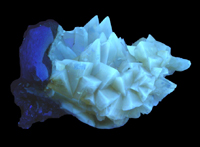Florida Calcite
Calcite crystals represent the most commonly-collected mineral from Florida. As most of Florida is underlain by Tertiary to recent marine limestones, the potential for crystal finds exists just about anywhere these limestones are exposed – most prominently in active limerock quarries.
A handful of localities have historically produced the bulk of collector-quality Florida calcites. These localities occur within specific regions, including the area around Marianna in the Panhandle, the Lecanto – Brooksville area in West-Central Florida, exposures of Miami Oolite in the Broward / Miami-Dade region of Southeast Florida, and scattered East-Central Florida exposures from shallow excavations. These excavations notably contained calcified mollusks, from localities in the Orlando area, south Brevard and central Indian River counties, and of course, Rucks Pit in Okeechobee County. Many other occurrences have been documented, including calcite replacing corals from Key Largo, a number of shallow occurrences from dredged canals and rock pits the Everglades and Southwest Florida, and even from limestone dredged from about 60 feet beneath the St. Johns River in Jacksonville. The “flos-ferri” variety of aragonite (polymorphic with calcite) has been found in a quarry north of Ocala.

Most recently, large Mercenaria permagna clams containing gemmy honey-amber calcite crystals were collected from the well-known find at Rucks’ Pit near Fort Drum. First discovered by Dr. Thomas Scott of the Florida Geological Survey, the clams were found in living position, and were largely confined to a stratigraphic zone 0.3 – 0.6m thick throughout the pit. Because these Mercenaria were found in hinge-up living position, it was suggested that they died in place due to a catastrophic event, such as sudden burial or freshwater poisoning resulting from a hurricane, tsunami or other causes. The age of these Mercenaria fossils is late Pliocene to early Pleistocene (1 – 1.5 million years old).
The size of the crystals (to over 3 cm in length) and the occurrence of many complete articulated crystal-filled clams make this occurrence unique. In all crystal-bearing specimens, portions of the sides (and sometimes tops) of the clam shells have been dissolved by ground water. This creates “natural windows” into each clam, allowing the internal crystallization to be more easily seen. The largest crystal clusters grow downward from the hinge area (top) of the clams. When found broken away from the rest of the fossil clam, these hinge pieces make outstanding thumbnail to small cabinet - sized crystal specimens.
The calcite from this site fluoresces a light yellow-green color under shortwave, midwave and longwave UV light, and also phosphoresces for a second or two once the black light is extinguished.

This site produced other calcified pelecypods, including Busycon rucksorum (Whelk), Anadara (Ark shells), and many others. Most calcite crystals within these mollusks were drusy, and lacked the deeper color and transparency of the larger crystals found growing within Mercenaria permagna clams.
Rucks’ Pit was an active mine, worked primarily for limerock used for road base material. Through an agreement with the owner, Apalachee Minerals and The Fossil Geode had exclusive commercial collecting privileges at this site, collecting from 2002-2005. The stratigraphic zone mined for aggregate was the same horizon from which the calcified Mercenaria occurred. Unfortunately, mining ceased in 2007 and the pit was allowed to completely flood.
In Florida, excavations and rock pits which uncover calcites and other interesting collector minerals are often only open for a short period of time before being reclaimed, flooded or built-over. Much productive specimen recovery has been a matter of being in the right place at the right time.
We are currently featuring a fine selection of top-quality calcite crystal specimens in Mercenaria permagna clams, collected directly from the fresh exposures within Rucks’ Pit in the mid-2000’s, before the pit was allowed to flood. Loose individual clam specimens are available, as well as the much rarer matrix specimens. We will also be adding calcites from other Florida localities to this section as they become available.
Click here to see our specimens